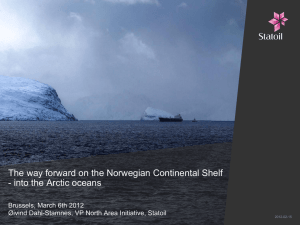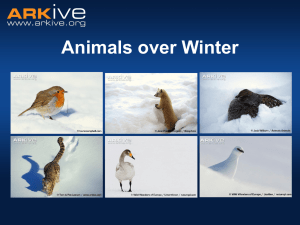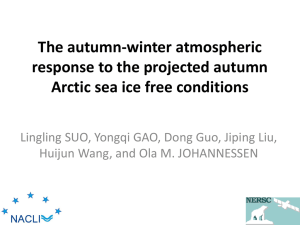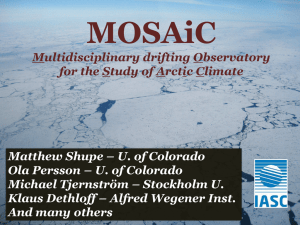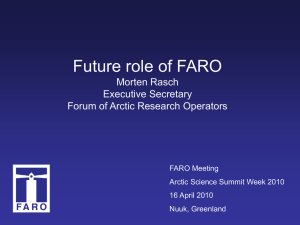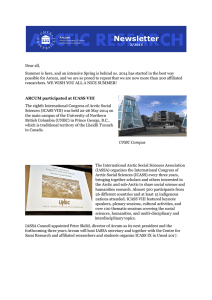Introduction to the Cultures of North American Aboriginal Peoples
advertisement
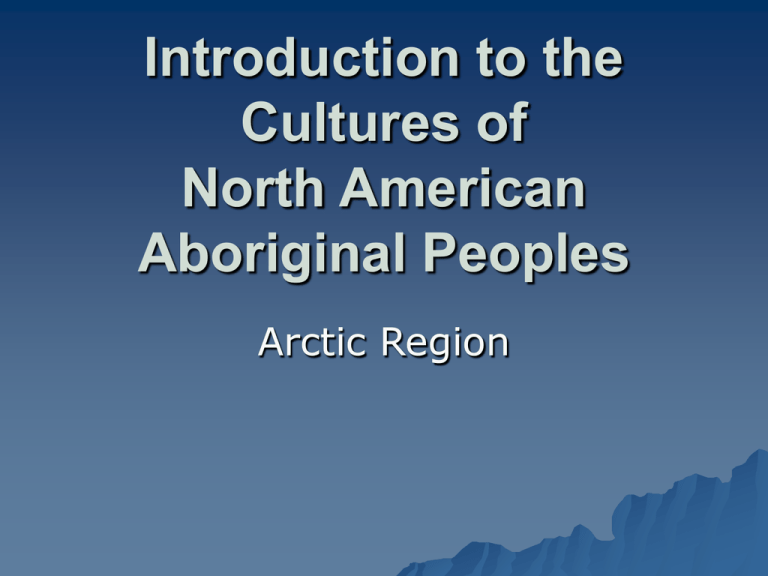
Introduction to the Cultures of North American Aboriginal Peoples Arctic Region Inhabitants Not “Indians” – Difference based on physical differences: Blood Types – ABO Eskimo/Aleut peoples have percentages similar to Euro-Asian peoples Indians lack antigen “B” – MN Blood Groups Same similarities Physical differences related to cold adaptation – Length of limbs – Breadth of trunk Physical Anthropology Group Type O Type A Type B Type AB Eskimo (Alaska ) 38 44 13 15 Indians (USA) 79 16 4 1 Navajo 73 27 0 0 Blackfo ot 17 82 0 1 Czech 30 44 18 9 Modern groups in the Arctic form a group distinct from the rest of the Americas’ aboriginal inhabitants This can be seen in a number of physiological and linguistic areas – Eskimo-Aleut languages are related to languages spoken in eastern Siberia and not to other languages of North America – Blood type distribution (see table) – Y-chromosome and mtDNA differences 32 Y-chromosome haplotypes Appears to indicate relationship (Haplotype 31) with groups in central Siberia Genetic distance between human populations based on research by Cavalii-Sforza Regional Characteristics (1) Arctic – Stretching from western Alaska across the entire continent to Greenland – Area north of the tree line – Classic tundra conditions during the Holocene. Cold, desert-like conditions. Growing season ranges from 50 to 60 days. Average winter temperature is -34° C Average summer temperature is 3-12° C Yearly precipitation, including melting snow, is 1525 cm – Flora Low shrubs, sedges (Cyperaceae), reindeer moss (Cladonia rangifera), liverworts (Hepaticae), and grasses 400 varieties of flowers crustose and foliose lichen Climate No region more affected by climate Long winters – Winter: Oct-May – Summer Jun-Sept Wind Relatively dry 20 15 10 5 High West East Brno 0 -5 -10 -15 -20 -25 -30 I IV VI X Tundra (Alaska National Wildlife Refuge) Coastal tundra Arctic Fauna: Terrestrial Mammals Terrestrial herbivores: – Caribou (Rangifer tarandus) [sob] – Musk oxen (Ovibus moschatus) [pižmoň] – Arctic hare (Lepus arcticus) [zajíc polární] – Lemming (Synaptomys spp.) [lumík] Terrestrial carnivores – Wolf (Canis lupus) – Arctic fox (Alopex lagopus) [liška polární] Arctic Fauna: Marine Mammals (1) Seals (true/eared) – Harp seal (Phoca groenlandicus) tuleň gronský Adult males grow to about 1.7 m and 130 kg; females are smaller – Ringed seal (Phoca hispida) tuleň kroužkovaný Adult ringed seals are 99-157 cm in length and weigh 45-107 kg – Ribbon seal (Phoca fasciata) tuleň pruhovaný Adult ribbon seals average 155-165 cm in length and 70-80 kg in weight – Bearded seal (Erignathus barbatus) tuleň vousatý Adult seals are 2.1-2.5 m in length, and weigh about 200-360 kg – Walrus (Odobenus rosmarus) mrož Atlantic walrus males average 3.0 m in length and weigh approximately 800-900 kg. Pacific walrus males are somewhat larger, averaging 3.2 m and approximately 1200 kg. Females are generally smaller – Northern fur seal (Callorhinus ursinus) lachtan medvědí Arctic Fauna: Marine Mammals (2) Whales (toothed/baleen – ozubení/kosticovici) – Beluga (Didelphinapterus leucas) běluha Adults measure 3-4.6 m and weigh 1350-1500 kg – Narwhal (Monodon monoceros) narval Adults: 4-4.9 m, 900-1600 kg, tooth: 2-3 m in length – Gray whale (Eschrichtius robustus) plejtvákovec šedý Adults are 13.8-15 m long and weigh about 33,000 kg – Northern right whale (Eubalaena glacialis) velryba biskajská Adults are 15-15.2 m long and weigh about 54,000 kg – Bowhead whale (Balaena mysticetus) velryba gronská Adults are 15-18.5 m long and weigh 72-91,000 kg Polar bear (Ursus maritimus) medvěd lední – Male polar bears grow two to three times the size of female polar bears – Males weigh about 350 to more than 650 kg and are about 2.5-3 m long – Females about 150 to 250 kg and are about 2 to 2.5 m Diversity and Density Western Arctic – highest diversity Central Arctic – lowest diversity and density Eastern Arctic – in between Stone tools: – No suitable raw materials for chipped stone – Emphasis on ground stone tools (slate) Extensive use of bone and ivory tools Knives Left: Ulu (woman’s knife) made of ground slate in a bone handle Right: Man’s knife made from ivory Oil lamps Only source of light and heat Fuel is blubber (fat of sea mammals) Used for melting snow for water Heating water for tea Not sufficient for cooking Other technology Human mobility Summer – restricted to water – Reduced mobility – Kyak – Umiak Winter – on land and sea (frozen) – Increased mobility – Dog sled Umiak Inuit kayak (max. length 5 m) More kyaks Kayak loaded with sealskin float, weapons, etc. Sled (toy) Dog sled team House Types - Summer Simple whalebone or driftwood frame Covered in animal skins House Types - winter W. & E. Arctic – Semisubterranean sod houses – Snow houses only used for short term living C. Arctic – Snow houses used longer term Seasonal residence patterns Western Arctic – Summer village 50-100 people Whaling – Winter dispersal Nuclear family groups Central Arctic – Summer dispersal – Winter village 60-100 people Winter Village Engraving from Frobisher expedition in 16th century Diet Meat Blubber/fat – No/minimal cooking Vitamnins Berries in summer – Cloudberry An amber-colored relative of the raspberry Grows on very small bushes Nerkraitorvik Hunting companions – Each hunter has 12 – Each of the 12 is referred to by a specific part of the seal – When a hunter kills a sea he exchanges that part with his named partner – Not necessary to participate in hunt to make claim Division of Labor Men – Hunting – Fishing – Butchering kills away from camp Women – Butchering kills in camp – Preparation of clothing Tanning leather Sewing – Family duties Both – Shamanism – Spiritual activities



